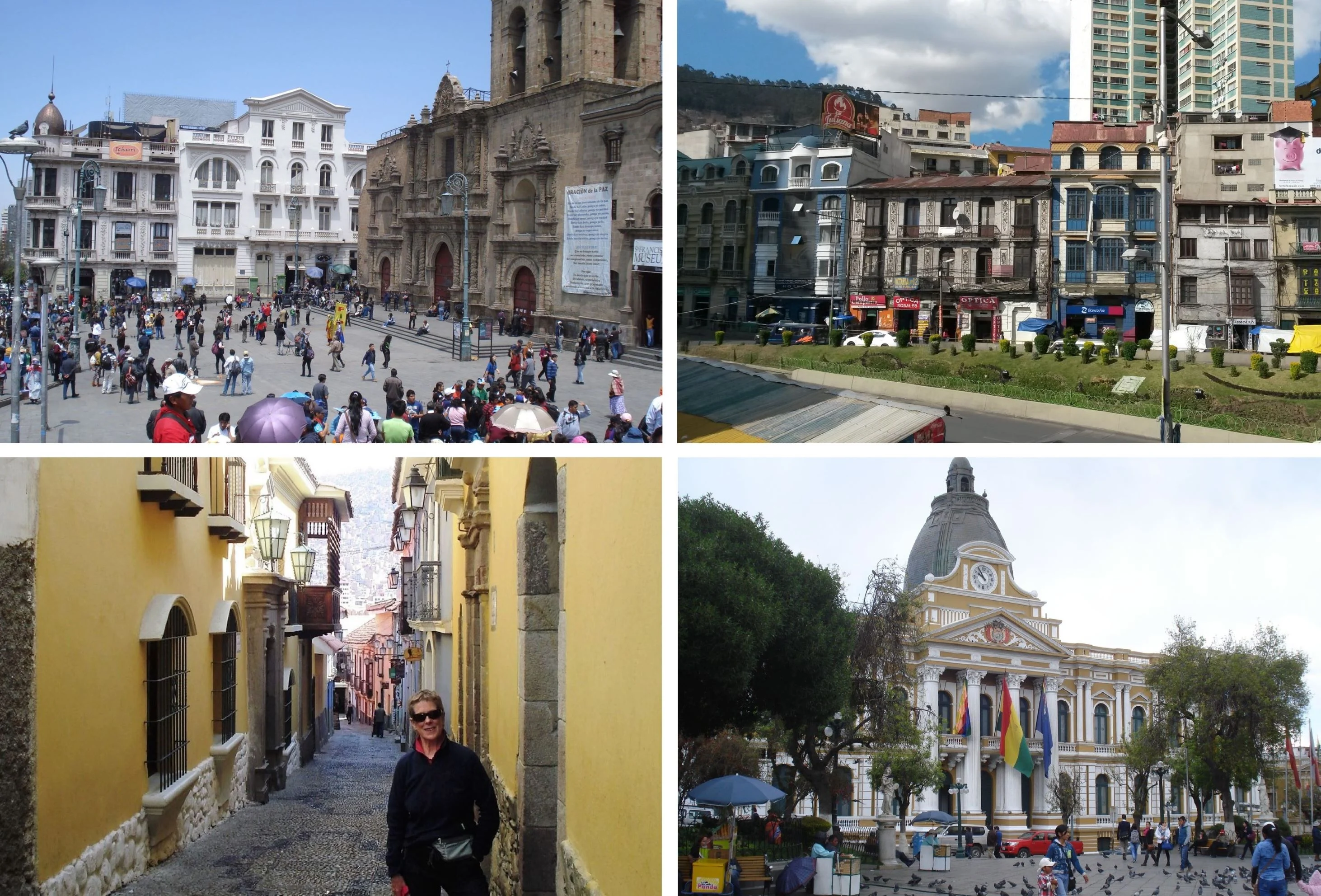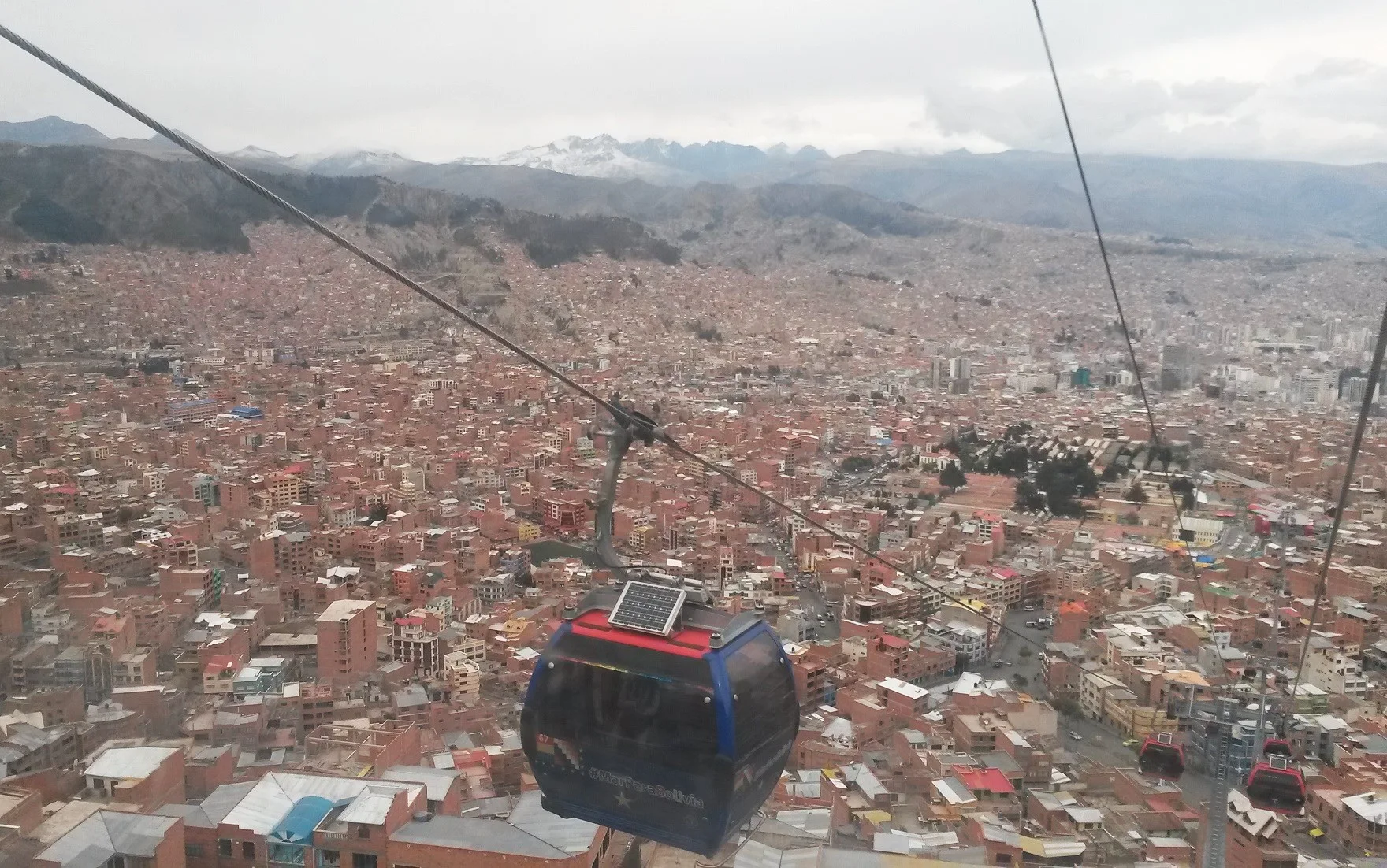Our bus left Bolivia's Cochabamba which is nestled in a valley of the Andes Mountains, and several hours later had climbed to La Paz, at the edge of the Andes Altiplano (high plains). La Paz is the administrative capital of Bolivia, and the highest capital city in the world at 3,650 metres above sea level.
 |
| Houses cascading down the bowl of La Paz, Bolivia |
We entered La Paz through El Alto which is the
highest part of the city at an altitude of 4,000 meters. From there we had an
amazing view of thousands of buildings, haphazardly funnelling down and around the
bowl-shaped valley that contains the centre of La Paz city - it was an amazing sight!
Our bus then crawled down through the mountains to the La Paz bus station, and from there we caught a taxi to Hotel Rosario, our accommodation for the next few days. This hotel proved to be a good choice as it
was in a central location in the historic heart of La Paz.
 |
| Marg at a street market in La Paz, Bolivia |
Around our hotel, there seemed to be a lot of
impromptu markets and street sellers. We realized later, that the whole city has
these and that's where everyone shops - there are no supermarkets here.
On a corner close to our hotel was La Paz's 'witches market'. It sells odd things that you imagine a witch
would use, such as dried frogs and llama foetus etc.
 |
| Witches market, La Paz, Bolivia |
It seemed small with only about half-a-dozen stalls, whereas it apparently once ran the length of the whole street. Perhaps there are fewer witches now-days, creating less of a demand for these items!
The women
selling, as with most of the women we’ve seen in Bolivia, wore Cholita clothing, the traditional dress of Bolivian women.
 |
| Women in traditional Cholita clothing, La Paz, Bolivia |
Cholita dress typically consist of a hat (traditionally a bowler, or other hat); a pollera (colourful ankle-length skirt); a shawl and/or an aguayo (embroidered cloth wrapped around the shoulders to carry things); flat shoes, and jewellery. Once a symbol of impoverished women, these days, the Cholita represents cultural pride.
La Paz is a mixture of narrow cobbled streets containing an interesting mix of shops and houses, and wide, well-treed streets containing larger businesses. We explored many of these with great interest, then walked
down through Plaza San Francisco to the main street called Paseo del Prado (or The Prado).
 |
| Top (L-R): Plaza San Francisco, the Prado. Below: Leigh in Calle Jaen, Plaza Murila |
After a good look around the interesting buildings and monument there, we
headed up some steep streets to Plaza Murila, a lovely square surrounded by imposing
colonial style government buildings.
Later, and with a little huffing and puffing in the altitude, we got to
Calle Jaen. This is a lovely old area with a cobbled
pedestrian street full of very attractive preserved colonial buildings, many of
which are now museums and galleries.
 |
| A teleférico in La Paz, Bolivia |
The next day, we took a ride up the hills
on the teleférico (cable car); an interesting part of the La Paz public
transport system. Rising up to El Alto we got fantastic views of the city
below.
Returning to the city centre later, we walked through the La Paz General Cemetery.
We’d spotted it from the teleférico and it seemed huge. We learned later that
it covers 92,000 square meters.
It is full of glass-fronted boxes in the cemetery walls, that contain the ashes of cremated people. There were families there with food and drink, presumably celebrating the lives of loved ones, and it seemed quite a joyous rather than sombre place. It was so different to our own culture and we found it very interesting.
Leaving there, we came across hundreds of people dashing to-and-fro across the road while trying to avoid the masses of buses and taxis that roared around them. It was a frenetic sight and very noisy, with lots of beeping and yelling.
 |
| Searching for a bargain at a roadside stall, La Paz, Bolivia |
They were trying to buy food from the many roadside vendors who spread their wares on a blanket or table at the side of the road. It seemed chaotic, but apparently it's a daily occurrence.
A few days later, we took a local mini-bus to the UNESCO site of Tiwanaku (aka Tiahuanacu) which is around 70 km from La Paz. The site contains the ruins of the capital of a Pre-Columbian empire
that flourished from AD 300 to 1000. It was amazing, with ruins that included huge stone enclosures, gateways and temples.
 |
| Leigh at Puerto de la Luna-Tiwanaku (UNESCO) |
These impressive structures were built from
stones weighing more than 25 tons which were somehow moved from the other side
of Lake Titicaca, over 100 kilometres away.
When we finished our tour, we went looking for
the mini-bus back to La Paz, only to be told it wasn't going for another two
hours! The driver offered to take us back early, but for a vastly inflated price.
Then two young Ecuadorian guys showed up and
also wanted to return to La Paz, so we told them that we would share the price if they were keen.
Luckily, with their Spanish and clever bargaining skills, we got a good deal, quick return, and interesting company back from Tiwanaku to La Paz. Overall, we had a great day and thought Tiwanaku was amazing.
We also really enjoyed La Paz; particularly its
historic centre. We had lots of great meals there, including llama
hamburgers and alpaca steaks. We tried local fruits like cactus
fruit, different breads, and wheat and corn products. Overall, we found it
to be a vibrant and interesting city.
After a good break in La Paz, we caught a tourist bus
to Copacabana which is on the Bolivian side of Lake Titicaca.
 |
| Bus on barge across Tiquina Strait-Lake Titicaca |
While we were waiting, we had a nice time
chatting to some of the other passengers; a young guy from France and a couple
from Brazil and England. It was interesting to share travel experiences before
getting back on the bus.
 |
| View of Lake Titicaca from our hotel room |
Reaching Copacabana, the bus driver dropped us
right outside our hotel, Hotel Estelar del Largo Titicaca, which is in a great
spot, and we had uninterrupted views of the lake.
Lake Titicaca is the highest navigable lake in the world at 3,850 m above sea level, and the largest lake in South America in terms of water volume.
Later we enjoyed a walk around Copacabana. It is a tourist town with hotels, restaurants, souvenir shops, travel agents and boat companies, all located on the shores of the famous lake.
 |
| Village on Isla del Sol-Lake Titicaca |
After a day or so, we took a trip from Copacabana to Isla del
Sol which is in the middle of Lake Titicaca. It is a rocky, hilly island with traditional villages, many ancient ruins, and no motor vehicles or paved roads.
We landed at the northern end of the island, and were delighted
to find Bruno
and Lorna plus their friend, who we had met on our bus trip from La Paz to Copacabana.
We decided to walk together to the top of the Island to explore the
ancient ruins there.
While admiring the sights, we were told that if we wished to
walk to the southern end of the Island where we were to catch our boat back to Copacabana, we
would have to walk fast to get there in time!
So off we went, to walk the length of the island. The walk is approximately 11 kms long, and goes up and down steep hills. We found it a little challenging in the high
altitude and heat.
 |
| Isla del Sol views |
But the views along the way were spectacular, and we had a
great time walking and chatting with our new friends.
Different villages along the way, charged a toll
to walk the track with the money going into the track's upkeep.
Near the end, was an amazing set of
very rugged and steep steps. They went downwards, on and on, to the shore and
our boat. At this stage, we realised that we were going to be late for the boat, so we had to race down those steps as fast as we could.
There were lots of people and donkeys with loads, going up and down the same steps. The donkeys were lovely and would step to one side to let
people go past. But it was not easy, given the steepness, roughness, and irregular size of the steps.
Eventually we made it to the boat, and
headed back to Copacabana tired but happy. We'd had a great trek on an historic island, with wonderful lake views, and interesting
people.
Sadly, Copacabana is our last stop in Bolivia.
 |
| Best of Bolivia-Uyuni Salt flats, architecture, people, Andes views |
We have just loved every part of Bolivia that we've seen. The amazing Uyuni Salt Flats, the interesting architecture, street parades, pride in culture, friendly people, and regular views of the Andes Mountains.
Bolivia is raw, interesting and cheap, but is rapidly changing. Our advice to other travellers is to find the time visit this country before it becomes too 'westernised' and touristy.
So, after a month in Bolivia, it was time to move on. We caught a Tour Peru bus to get us across the border out of Bolivia and into the city of Puno in Peru, which is
on the other side of Lake Titicaca, and our next destination.
This
is part of a blog series about our travels through the north-eastern countries
of South America. The first blog in this series is called “In and around Santiago”.



